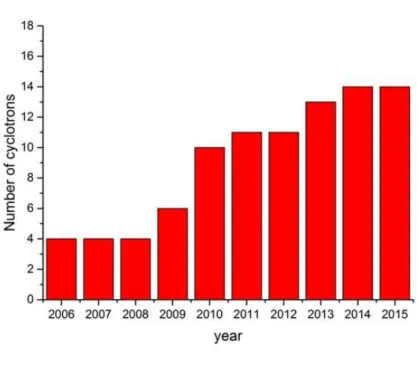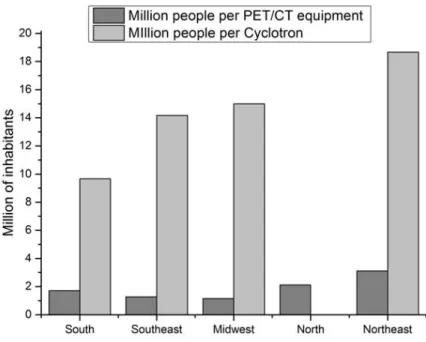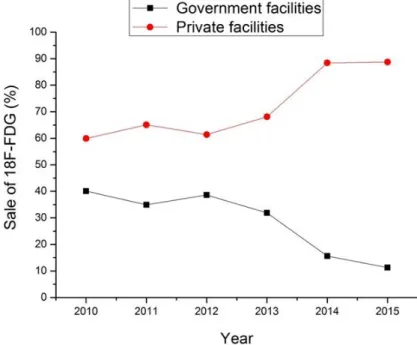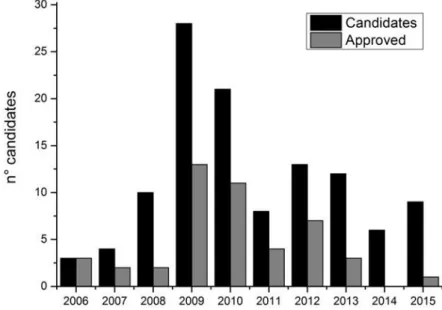BJRS
RADIATION SCIENCES
05-02 (2017) 01-09Cyclotron facilities in Brazil: Current status and licensing
aspects
A. Facure
a; S. M. Carvalho
a; R. Di Prinzio
a; C. S. Silveira
a; P. B. R. Gasparian
a; W.
F. França
aaBrazilian Nuclear Energy Commission, 22294-900, Rio de Janeiro, RJ, Brazil
facure@cnen.gov.br
ABSTRACT
Positron Emission Tomography (PET) is a highly sensitive and accurate nuclear medicine imaging technology but the major problem of this technique is the use of radioisotopes with short half-life, less than two hours. The production and selling of short half-life radioisotopes used to be monopoly of the Brazilian Government. In 2006, a Constitutional Amendment revoked the state monopoly due to the need for the use of short half-life radioisotopes in nuclear medicine centers very far from the government production facilities. The aim of this study is to describe the current status of short half-life radioisotopes production in Brazil and discuss some licensing process. In Brazil, as has been occurring worldwide, the number of nuclear medicine centers is increasing. Currently there are 123 services performing PET scans in Brazil. There are 14 cyclotrons operating in Brazil. The type of licensing process conducted in Brazil does not take into account the population density of each state, with a free competition model being adopted. Because of this there is a lot of equipment concentrated in the Southeast and no cyclotrons operating in the Northern part of the country. One of the biggest obstacles during the licensing process is the designation of qualified personnel as operation workers and radiation safety officers. The number of cyclotron accelerators and PET/CT equipment increased in recent years. However, a number of external factors such as the distance from the nuclear medicine centers, and qualified personnel have proved crucial for the economic viability of this type of facility.
1. INTRODUCTION
The applications of cyclotron produced isotopes have been expanding at a much faster pace in the last 15 years, as seen by the large number of new machines being installed (1). The positron emis-sion tomography has become a diagnostic technique well established and widely used in oncology for diagnosis, staging, radiotherapy planning and follow-up, as well as for several studies in cardi-ology and neurcardi-ology areas. Currently, fluorodeoxyglucose (FDG) is the most widely used radio-pharmaceutical in PET/CT scans due to its half-life of 110 minutes, which allows the transportation from a production facility to hospitals located in distinct (farther) areas.
In Brazil, as has been occurring worldwide, the number of nuclear medicine centers is increasing. Currently there are 394 nuclear medicine services in Brazil; 123 of them routinely performing PET scans. Until 2006, the production and selling of short half-life radioisotopes was monopoly of the Brazilian Nuclear Energy Commission. However, given the need for the use of short half-life radio-isotopes in nuclear medicine centers very far from the government production facilities, in the year of 2006 a Constitutional Amendment revoked the above mentioned state monopoly. This allowed private cyclotrons to start operation, for the production of various positron emitting radioisotopes, such as 18F. Establishing an FDG manufacturing facility requires considering two applicable regu-latory aspects: radiopharmaceutical manufacturing and radiation protection. More importantly, a facility must be adequate to manufacturing FDG conforming to required quality attributes and safe for human use (2).
The production of radionuclides with an accelerator requires that particle beams be delivered with two specific characteristics. The beams must have sufficient energy to bring about the required nu-clear reactions, and sufficient beam current to give practical yields. The basic characteristics of all cyclotrons are equal: there is an ion source, an acceleration chamber and a magnet to keep the ions on a circular path (3).
This paper describes the current status of the cyclotrons facilities in Brazil, exposing the increase in the number of these facilities and their geographical distribution. In addition, statistics are presented regarding 18F production and issues related to licensing, like the average time for issuing the
admin-istrative acts and the need for training and certification of professionals. Some of the major non-conformities observed in regulatory inspections, are also discussed.
2. MATERIALS AND METHODS
The current number of cyclotrons and certified professionals in Brazil were evaluated. This survey was performed using a database system (ONBASE) of the Brazilian Nuclear Energy Commission.
3. RESULTS AND DISCUSSION
3.1 Cyclotron facilities in Brazil
In order to carry out a practice, all the actions and stages must be considered, from the choice of the location to the decommissioning, or until the end of the institutional control of the facility (4). The decision to install a new radioisotope production facility is generally based on national and institu-tional policies on science, technology and healthcare. Establishing a cyclotron facility for producing radionuclides and/or manufacturing radiopharmaceuticals is a complex process and requires careful planning in order to be successful. In addition to the technological complexity requiring a highly skilled staff, it is also costly to build and to operate (5) this type of facility.
In Figure 1, the increase in the number of operating cyclotrons for radioisotope production in Brazil is illustrated. As can be observed, until the year of 2006 there were only four public cyclotrons pro-ducing radioisotopes.
Figure 1. Increase in the number of cyclotrons operating in Brazil, for radioisotopes production,
since 2006.
One of the public cyclotrons that is still operating in Brazil is no longer commercially available. Considering the accelerators that are still available on the market, for a total of nine existing manu-facturers, only three of them installed equipment in Brazil: IBA, General Electric Company (GE) and Siemens. The last two also provide self-shielded cyclotrons. Table 1 illustrates the current dis-tribution of cyclotrons operating in Brazil, by manufacturer.
Table 1. Cyclotron manufacturer distribution in Brazil
Manufacturer Number of accelerators
IBA 4
GE 6
Siemens 3
3.2 Geographical distribution of cyclotrons and PET/CT scanners in Brazil
Figure 2 illustrates the distribution of cyclotrons accelerators and PET/CT scanners in Brazil. There is a lot of equipment that is still concentrated in the Southeast, especially in São Paulo, Brazil's most populous and wealthiest state. There are no cyclotrons operating in the northern part of the country.
Figure 2. Geographical distribution of cyclotrons and PET/CT scanners in Brazil, for the year
2016.
It must be emphasized that in 2010, only 30 equipment of PET/CT were operating in the country. From 2010 to 2015, an increase by a factor 4 was observed in the number of facilities that perform this type of procedure.
In Figure 3, the current number of inhabitants for each PET/CT and cyclotron accelerator for each geographic region of Brazil is illustrated. Considering cyclotron accelerators distribution per inhab-itants, it can be seen that the south presents a more favourable distribution, with a lower number of people being attended by each machine. However, the southeast region exhibits a better distribution
concerning PET/CT equipment per million people. It should be highlighted that, since the begin-ning of the licensing process of private cyclotrons in Brazil, no government policy has been adopted in order to establish the number of cyclotrons per number of inhabitants or to determine the geo-graphic region where the accelerator should be installed. The installation of cyclotron accelerators in Brazil has been carried out through free competition and according to the market.
Figure 3. Number of inhabitants per cyclotrons and PET/CT equipment in Brazil, for the year
2016.
3.3 FDG production in Brazil
One major problem when performing PET/CT scans is the use of radioisotopes with short half-life, less than two hours, which in some cases makes the transport from the production facility to distant centers prohibitive. Based on its half-life (110 minutes) the fluorodeoxyglucose (FDG) is the most used radiopharmaceutical in PET scans. In the last 5years, the average FDG activity sent to nuclear
medicine services in Brazil was 507 GBq (~ 13.7 Ci) per week, considering the production of all cyclotrons in operation.
Figure 4 shows the FDG sales percentage for cyclotrons from government and private facilities in the last 5 years. It is possible to observe that private cyclotrons already exceed the government pro-duction and sale, and nowadays the private cyclotrons are responsible of almost 90% of total trade.
Figure 4. FDG sales percentage for government and private facilities.
3.4 Considerations about the licensing process
The average period for issuing an Authorization for Operation for a cyclotron facility in Brazil has been 2 years and 2 months, from the initial notification. One of the biggest obstacles observed dur-ing the licensdur-ing process is the designation of qualified personnel as operation workers and radia-tion safety officers. In recent years, it was observed a significant increase in the number of of can-didates for radiation protection officer certification, with a subsequent reduction. Figure 5 shows the
results of the tests applied by the Brazilian Nuclear Energy Commission, for the certification of cyclotron radiation safety officers.
Figure 5. Number of candidates and approval of cyclotron radiation protection officers in Brazil.
Regarding regulatory inspection in Brazil, during the cyclotron facilities licensing process two types of inspections are usually performed: one to monitor the FDG production (usually overnight) and another to verify records and to test security systems. In the recent years, the most non-conformities observed during regulatory inspections are related to the absence of health certificates for workers, improper area signalling, lack of records of monitoring results and the absence of suitable materials for small decontamination.
4. CONCLUSION
This paper briefly presents the state of the licensing process of cyclotrons facilities in Brazil nine years after the opening of the market to the private sector. It is possible to see a significant growth in the number of cyclotron accelerators and PET/CT equipment in recent years, with a tendency towards stabilization.
Regarding the participation of the Brazilian government in FDG production and sale, the reduction in the share is due to several reasons, such as lack of staff and difficulty in keeping equipment maintenance contracts.
The type of licensing process conducted in Brazil does not take into account the population density of each state, with a free competition model being adopted. However, nowadays a number of exter-nal factors (such as the distance from the nuclear medicine centers) have proved crucial for the eco-nomic viability of this type of facility.
REFERENCES
1. IAEA – International Atomic Energy Agency. Cyclotron produced radionuclides: principles and practice. TRS 465, Vienna: IAEA, 2008.
2. IAEA – International Atomic Energy Agency. Radioisotopes and Radiopharmaceuticals Se-ries. Cyclotron produced radionuclides: guidance on facility design and production of [18F]fluorodeoxyglucose (FDG). Vienna: IAEA, 2012.
3. IAEA – International Atomic Energy Agency. Cyclotron produced radionuclides: physical characteristics and production methods. TRS 468, Vienna: IAEA, 2009.
4. CNEN – Comissão Nacional de Energia Nuclear. Diretrizes Básicas de Proteção Radiológica. Norma CNEN NN 3.01, Rio de Janeiro: CNEN, 2011.
5. IAEA – International Atomic Energy Agency. Cyclotron produced radionuclides: guidelines for setting up a facility. TRS 471, Vienna: IAEA, 2009.
6. European Commission on Nuclear Safety and the Environment. Evaluation of the Radiologi-cal and Economic Consequences of Decommissioning Particle Accelerators. Report EUR 19151EN, Brussel, 1999.
7. IAEA – International Atomic Energy Agency. Generic models for use in assessing the impact of discharges of radioactive substances to the environment. SRS 19, Vienna: IAEA, 2001.




